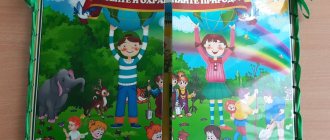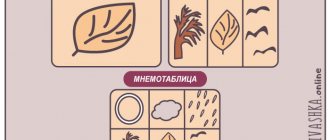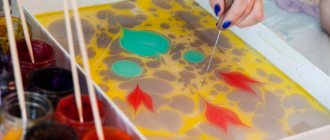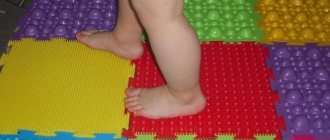Lapbook as an original innovative guide, beautiful and useful
The author of the manual is considered to be American Tammy Dubey. She came up with the idea of filling a small folder with a variety of pictures, pockets, rhymes, and paper crafts to reinforce and preserve the information she had learned with her children. Photos of the first lapbooks found their way onto the Internet and this manual became the property of all concerned parents, educators and teachers. Lapbooking (production of lapbooks) is recognized as an innovative technology with many advantages.
The very name of the manual is translated from English either as a “knee book” or as a “folding book”, and both options are completely fair. Lapbooks are small in size (usually A4 format when folded) and it is convenient for a child to look at them while holding them on his lap. In addition, these wonderful books are full of riddles and secrets, they fold out and have many pockets, inserts, notepads, which in turn open, which is very much to the taste of little researchers and lovers of secrets.
Studying a laptop begins with looking at all the treasures hidden in it.
What game elements are included in the layout and why?
Lapbooks for preschoolers are distinguished by a greater (compared to school) presence of game elements. These are rotating circles, opening windows, moving parts and figures. The first impression of a lapbook is usually for both children and adults: it’s fun, entertaining. But this is how it should be, because preschool children learn about the world through play. The first two or three lessons with a laptop will definitely be devoted to studying its wonderful properties and capabilities as a toy, and only after that the kids will be able to comprehend the useful information contained in it. There is no point in rushing children; their involuntary memory and attention are very developed, and unnoticed by themselves, by manipulating with pockets, circles and pictures, they will learn a fairly extensive amount of information.
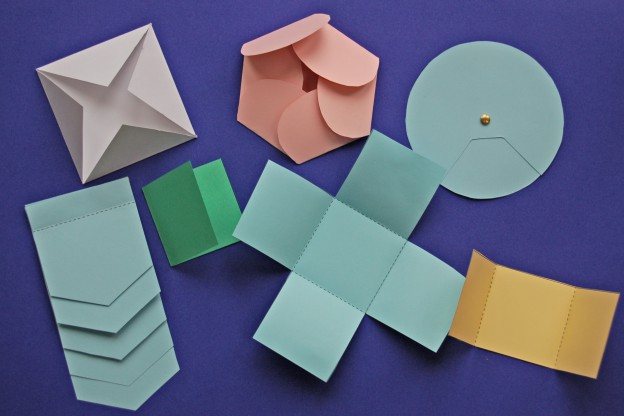
It is thanks to such unusual elements that kids really like lapbooks.
Benefits for preschoolers and teachers
Two significant features of the laptop should be noted:
- Interactivity. The child interacts with the folder, rather than just looking at it. Active participation greatly increases interest in the benefit. This is especially important for kinesthetic children (with a predominance of the sense of touch as a means of understanding the world around them), because it is no secret that in the modern educational process visual methods predominate (demonstration of illustrations, videos and slides), as well as the use of music and audio recordings.
- Thematic. It is difficult to collect information on different topics in a small folder; it will be difficult for children to assimilate and understand it, so lapbooks are usually dedicated to one topic, for example, “Autumn”, “Birds”, “Family”. In the older group, which involves a more in-depth study of certain topics, it is possible to cover a more specific subtopic in the lapbook: “Gifts of Autumn”, “Wintering Birds”, “Family Holidays”.
Thus, a modern lapbook is a thematic interactive folder (book) containing systematized and variously designed information.

Usually the title page of a folder already announces its topic.
The purposes for using lapbooks are also very diverse. This includes consolidating everything that children have learned during the project, learning to collect and systematize information, developing creativity and creativity, and fostering a caring attitude towards a product made collectively, and respect for common work. One of the most important objectives of the manual is considered to be the stimulation of cognitive activity in children, the desire to learn and remember new things, and in older preschool age, the awakening of the desire to learn.
Lapbook technology as a modern means of teaching preschool children
November 22, 2021
Elena Olegovna
Educator
The article is devoted to the use of modern technology “lapbook” as a means of teaching preschool children. Assignments and entertaining material on various topics can be used both when organizing educational activities and when working individually with children.
In the context of modernization of preschool education, the standard requirements for mastery results are presented in the form of educational targets, which represent the social and psychological characteristics of the child’s possible achievements at the stage of completing the level of preschool education. One of the final results of educating a kindergarten graduate is the child’s mastery of basic cultural methods of activity, the manifestation of initiative and independence in various types of activities; ability to independently select participants in joint activities.
“Lapbook” is a relatively new teaching tool that came to Russian education from America. Literally translated from English, “lapbook” means “knee book” (lap - knees, book - book).
According to the authors of articles posted on various websites and in periodicals, a lapbook is a thematic folder in which materials on the topic being studied are placed. Instead of pages, the folder contains various mini-folding books with pockets, doors, windows, tabs and moving parts.
Thus, we can say that a lapbook is a collective image of a poster, book and handouts, which is aimed at developing creative potential within a given topic, expanding not only one’s horizons, but also developing skills and abilities.
Today, the development of cognitive abilities and activity of preschool children is one of the pressing problems of our time. There is an opinion that it is necessary to teach a child to read and count as early as possible. However, it is more important to develop his thinking, attention, speech, awaken interest in the world around him, develop the ability to make discoveries and be surprised by them.
One of the promising technologies that helps solve this problem is the laptop.
A laptop is a universal guide that can be the result of children’s project-based and independent activities, a thematic week provided for by the main educational program of a preschool educational organization. Can be used in the implementation of any of the educational areas, ensuring their integration.
By combining teaching and upbringing into a holistic educational process, a lapbook allows the teacher to build activities based on the individual characteristics of each child, to create conditions under which the child himself becomes active in choosing the content of his education: he participates in searching, analyzing and sorting information.
What's new?
Time does not stand still; our modern society requires a new education system - innovative learning.
The Ministry of Education and Science of the Russian Federation has provided us with a qualitatively new model of education - the Federal State Educational Standard for Preschool Education.
In the search for various technologies that would ensure we achieve our goals, a new gaming technology, Lapbook, was found and began to be actively introduced into the pedagogical space of kindergartens.
A laptop is a new modern form of joint activity between an adult and a child, which can have an interesting continuation as an independent activity of a child and a common activity of two or more children. It creates conditions for the development of the child’s personality, motivation and abilities. It develops creativity and creative thinking. And this book also brings the team and family together for a fun and useful activity!
At first glance, something new and unknown turns out to be a technology that combines many of the actions we previously performed. The most important value of the Lapbook is that it allows the child to be a participant in the entire process, at any of its stages. It allows you to hear the child’s voice and understand what he wants. The child’s voice is especially valuable: if we don’t hear it, there will be no curiosity, arbitrariness, initiative, or willingness to change.
Lapbook develops creativity and communication skills. And it's just interesting! Preschoolers need emotional, vibrant and exciting activities!
Why is lapbook technology relevant today?
Firstly, the laptop meets the requirements of the Federal State Educational Standard for preschool education for a spatial subject-development environment:
- multifunctional: promotes the development of creativity and imagination.
- suitable for use by a group of children at the same time (including with the participation of an adult as a playing partner);
- has didactic properties, contains ways of getting acquainted with color, shape, the surrounding world, etc.;
- is a means of artistic and aesthetic development of the child, introduces him to the world of art;
- variable (there are several options for using each part);
- its structure and content are accessible to preschool children;
- provides playful, educational, research and creative activity for all pupils.
Secondly, working with a laptop corresponds to the main directions of partnership between an adult and children:
- involvement of the teacher on an equal basis with the children;
- voluntary participation of children in activities;
- free communication and movement of children during activities;
- open time end of activity (everyone works at their own pace.
One of the important conditions for the implementation of the educational program in preschool educational institutions in accordance with the Federal State Educational Standard is the cooperation of teachers with the family: children, educators and parents are the main participants in the pedagogical process. The creation of such an interactive book makes it possible to make parents active participants in the pedagogical process, giving them the opportunity to collect material for the book, offer ideas for creating different books, and make parts of the book.
Lapbooks can be made by both children and adults, of completely different ages and levels, and on very diverse topics. This could be an entire mini-encyclopedia, or it could become your group project or even your first research collaboration with children and parents! Well, the main thing in a lapbook, no matter what basis you choose, is the mini-books inside - tiny folding beds, accordions, pockets, etc., in which you organize the information you need. The process of preparing to create a lapbook can be very interesting and exciting; the main thing is for the teacher to think about how to organize his work and productivity will be very high if he actively works with children and involves parents.
Parents help in collecting poems, riddles, fairy tales, illustrations on the topic, pictures for speech development, and in making mini-albums with printed photos from walks. There you can include signs of nature, natural phenomena, a calendar of observations, and much more.
The result of using this manual is:
Uniting children, parents and teachers, that is, a social orientation.
Children learn to find information on their own, that is, they learn to learn.
Creative thinking, curiosity, resourcefulness, imagination, fine motor skills, and spatial orientation develop, which is closely related to the development of speech.
Expanding children's understanding of the world around them.
The child learns to independently collect and organize information - good preparation for research activities.
Thus, I believe that the use of such innovative gaming technology as the lapbook is a successful step towards the implementation of the Federal State Educational Standard for Education. After all, it allows us to use innovative methods and forms of work, and implement the basic principles: to be open to the family, to cooperate with parents in raising children, to create a unified developmental environment, to ensure the same approaches to child development in the family and kindergarten.
Share with friends
Consultation for educators “Methodology for memorizing poems”Modern sports and health systems of physical exercises
You do not have sufficient rights to add comments
You must be logged in to post comments. If you do not yet have an account on our website, we invite you to register. It will take no more than 5 minutes.
Types of lapbooks
Thematic folders come in several types. They are mainly distinguished by the method of application.
Types of benefits depending on purpose and content
It is customary to distinguish the following types of laptops according to their purpose:
- Gaming . This folder is intended for play, together with a teacher or for an independent child, so the main emphasis in it must be on entertainment and ease of perception of information. In addition to movable game elements (windows, circles, sliding pockets-petals), you can put into it the now popular walking games, cards for logic games like “Who am I?”, “What did I wish for?”, small items for the game “What” in my hand?”, “Guess by touch” in a small fabric bag.
- Educational (encyclopedic) . An excellent tool for organized educational activities and individual work to consolidate a specific topic. In such a lapbook you can place not only educational games, memory cards, proverbs, but also interesting facts, folk signs, and quiz questions. Naturally, children will be able to use such a benefit with the help of a teacher.
- Congratulatory . It will be an original and very pleasant gift for a loved one whose tastes and hobbies you know well. A daughter’s best friend would like a lapbook made together with her mother, in which there is room for shared photographs of the girlfriends, a paper doll with a set of dresses and accessories, a hand-sewn rag doll, and a small flat box with children’s jewelry. A lapbook as a gift for a boy can be filled with magnets with images of dinosaurs, cartoon characters, a wooden construction set (its parts are flat and will fit in an envelope), photographs of your favorite athletes, cars.
- Autobiographical . This can be either the story of one child (the parents help the child make the materials and design at home), or the life story of one kindergarten group, which will contain photos, crafts and funny sayings of the kids. When making the “Our Group” lapbook, it is important to distribute the material so that each child receives attention, each is present in some section and in at least one of the photographs.

This New Year's lapbook will be a wonderful gift for the whole family.
Differences in lapbooks depending on the age of children
Equally important is the division of lapbooks according to the age of the children. Thematic folders for primary preschool age are distinguished by a smaller number of pages, interactive elements, more general coverage of information, and large details.
Experts who use lapbooks in depth recommend their use in working with children aged five years and older, but even at a younger age, under the supervision of a teacher, children can work with a lapbook and learn how to put things in order (fold pictures into envelopes, fold and close petals “secrets”, etc.). Folders for the development of color perception in combination with tactile perception (with elements made of multi-colored felt, fabric, fur, burlap) will be useful at this age.

A laptop for little ones has large elements and a minimum of tasks.
For fidgety four-year-olds of the middle group, folders with a large number of moving elements, puzzles, and simple logic problems (“Find a pair,” “What’s extra?”) are suitable. This simultaneously helps to develop children and satisfy their natural curiosity at this age.
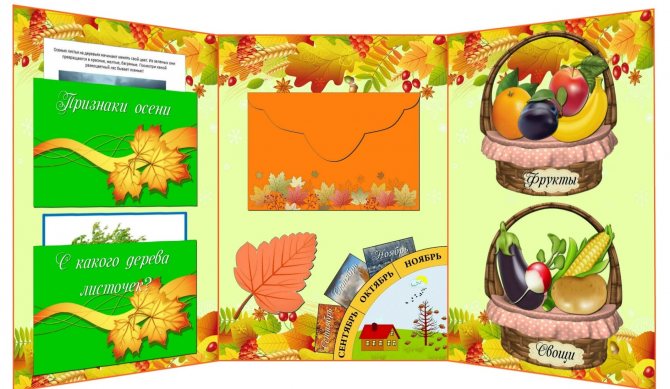
Children of the middle group will enthusiastically consolidate their knowledge about fruits and vegetables by placing pictures in the right baskets
Older preschoolers show not only interest in the entertainment possibilities of a lapbook, but also inquisitiveness and consistency in mastering the knowledge contained in it. They are interested in both looking at the image and learning new information about it. Therefore, in pictures in folders, you can place short texts with educational information on the back. Children often ask the teacher to read them, memorize them and retell them to their friends.
The development of thinking and improved memory of children of the sixth or seventh year of life justifies the complication of the material presented. Older preschoolers have access to the games “Remember the Proverb”, “Read the Poem”, “Words-Relatives”, in which it is necessary to reproduce a certain text from a picture. Children of this age are also interested in logical games “What comes first, what comes next”, “Put the pictures in order”, “Part and whole”, “Opposites”. They are placed in a laptop, selecting images in accordance with the theme.

The folder for older preschool age contains much more text information and related tasks
Materials and shape of the interactive folder
The material from which lapbooks are made can be very diverse, the main thing is that it is approved for use in preschool institutions. For this reason, it is better not to use some types of building materials (ceiling tiles, finishing plastic), because inexpensive types of them may be of poor quality, and those that meet the standards “bite” in price. Therefore, it is better to focus on familiar, safe materials: cardboard, whatman paper, colored paper. Cardboard boxes for sweets, cookies, ready-made A4 folders, folders for manual labor, where additional sheets are glued, are also suitable for the base.
The shapes of lapbooks depend on the imagination of their creators:
- Classic rectangular;
- Square, oval, in the form of other geometric shapes;
- Reflecting the theme of the folder, that is, in the form of a nesting doll, a cup, a bird, a flower, a cloud.
When choosing a shaped option, you should remember that the lapbook will be used often, and too small, thin parts, for example, the spout of a teapot or the stem of a flower, may simply fall off.
Recently, a “lapbox” manual has appeared, that is, a “folding box”. It is distinguished by its design, in which parts of the product are folded into a box and secured with tape or fasteners. When the fastening is removed, the laptop “disintegrates”, revealing the contents of the walls, that is, the same envelopes, notebooks, and other elements. This impressive manual is suitable for games and gifts, but is still little used as a teaching tool.
Video: playing with lapbox in a kindergarten group
Lapbooks in the form of books with a small number of pages, folders with inserts and accordion screens have taken root in kindergartens. It is difficult for children to hold the latter on their laps; they are used on a table or rug.
Photo gallery: types of lapbooks used by kindergarten teachers
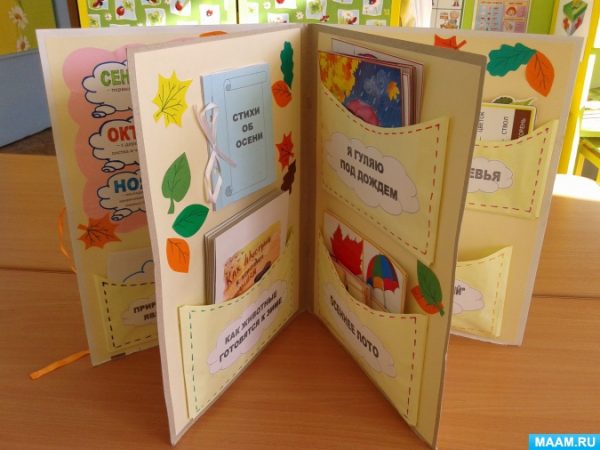
A traditional version of a lapbook from a ready-made stationery folder with inserts
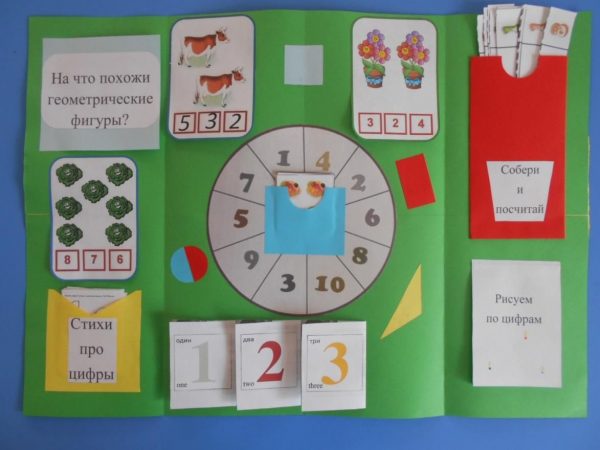
This lapbook will help young mathematicians navigate the world of numbers and figures.
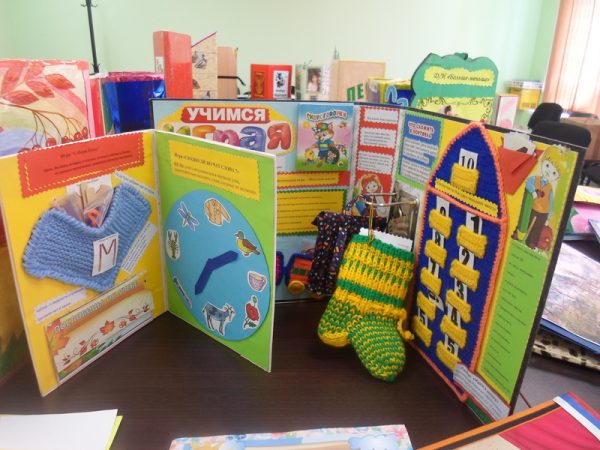
An original version of a lapbook with knitted elements from handicraft educators

You can't do without letters in a literacy lapbook
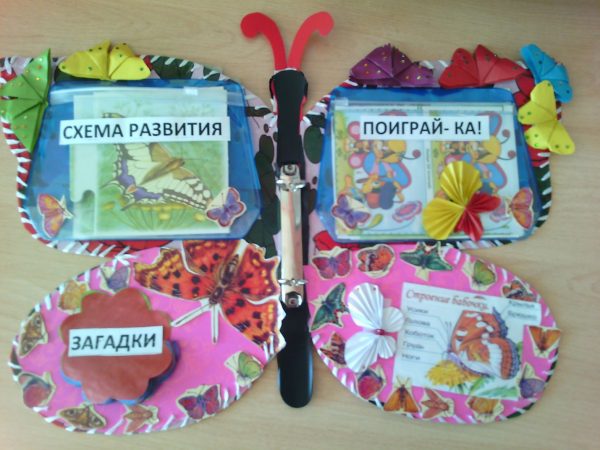
A butterfly-shaped folder will teach kids about these wonderful insects.
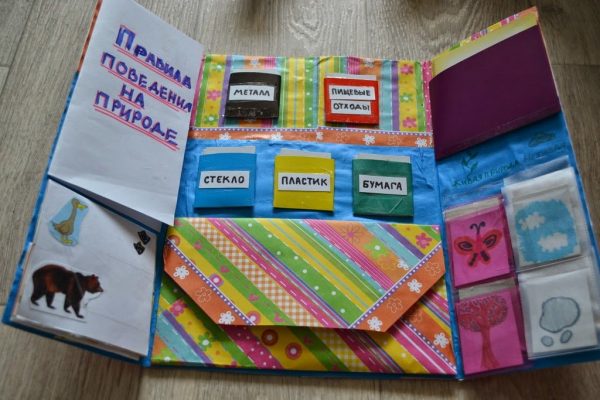
An ecology laptop will teach kids how to sort garbage
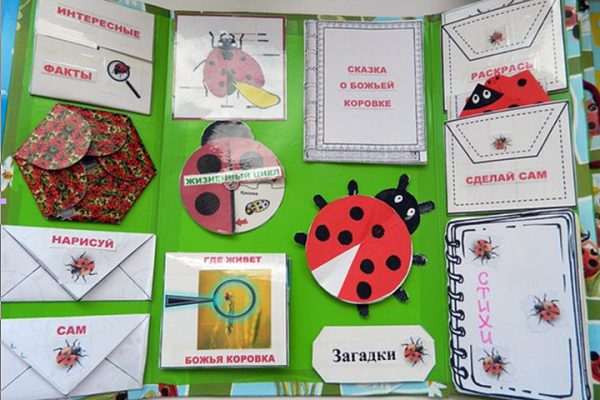
The interactive folder about the ladybug looks elegant and is filled with interesting tasks
Article Lapbook as an innovative technology in preschool educational institutions. Author: Muravyova Tatyana Nikolaevna
Author: Muravyova Tatyana Nikolaevna Every teacher is looking for new approaches, ideas, forms and methods in their pedagogical activities that would be interesting to preschoolers and would be appropriate for their age, and most effectively solve pedagogical, educational and educational problems. In my work with children I use such innovative technology as the laptop.
Author: Muravyova Tatyana Nikolaevna Muravyova Tatyana Nikolaevna Teacher of the highest qualification category of MKDOU Kindergarten No. 5 in the city of Plast G. Plast LAPTOP BOOK AS AN INNOVATIVE TECHNOLOGY IN A PRESIDENTIAL OUGH Modern requirements imposed by the state on the quality of educational activities in kindergarten imply that the teacher needs constantly engage in self-education, increase your level of professional competence and master the necessary educational technologies. In connection with the implementation of the Federal State Educational Standard for preschool education, every teacher is looking for new approaches, ideas, forms and methods in their teaching activities that would be interesting to preschoolers and would be appropriate to their age, and would most effectively solve pedagogical, educational and educational problems. More recently, a completely new technology, a new teaching tool, and an interesting teaching aid have appeared in modern pedagogy - the lapbook. Today I want to tell you about a miracle book called lebpuk. Nowadays such books are gaining more and more popularity. Despite its apparent simplicity, the lapbook contains all the necessary materials on a given topic. Lapbooks can be adapted for any age and level of preparedness and development of a preschooler. All lapbook materials correspond to a specific topic and carry educational and developmental functions. Lapbook is a relatively new tool from America and is one of the types of gaming technology. Tatyana Pirozhenko adapted it to our mentality. She developed this technology for activities with her child and suggested using it in working with children. Literally translated from English, a lapbook means a book on your lap, or as it is also called a thematic folder or a collection of small books with pockets and windows that make it possible to place information in the form of drawings, small texts, diagrams and graphs in any form and on any topic. . This is a book that the teacher collects, glues its individual parts into a single whole, and creatively designs using all kinds of colors and shapes. Most often, the basis for a lapbook is hard paper or cardboard, the main thing is that the lapbook is sized to fit on your lap. Thus, we can say that a lapbook is a collective image of a poster, book and handouts, which is aimed at developing creative potential within a given topic, expanding not only one’s horizons, but also developing skills and abilities. Today, the development of cognitive abilities and activity of preschool children is one of the pressing problems of our time. There is an opinion that it is necessary to teach a child to read and count as early as possible. However, it is more important to develop his thinking, attention, speech, awaken interest in the world around him, develop the ability to make discoveries and be surprised by them. One of the promising technologies that helps solve this problem is the laptop. A laptop is a universal guide that can be the result of children’s project-based and independent activities, a thematic week provided for by the main educational program of a preschool educational organization. Can be used in the implementation of any of the educational areas, ensuring their integration. By combining teaching and upbringing into a holistic educational process, a lapbook allows the teacher to build activities based on the individual characteristics of each child, to create conditions under which the child himself becomes active in choosing the content of his education: he participates in searching, analyzing and sorting information. What's new? Time does not stand still; our modern society requires a new education system - innovative learning. The Ministry of Education and Science of the Russian Federation has provided us with a qualitatively new model of education - the Federal State Educational Standard for Preschool Education. In the search for various technologies that would ensure we achieve our goals, a new gaming technology, Lapbook, was found and began to be actively introduced into the pedagogical space of kindergartens. A laptop is a new modern form of joint activity between an adult and a child, which can have an interesting continuation as an independent activity of a child and a common activity of two or more children. It creates conditions for the development of the child’s personality, motivation and abilities. It develops creativity and creative thinking. And this book also brings the team and family together for a fun and useful activity! At first glance, something new and unknown turns out to be a technology that combines many of the actions we previously performed. The most important value of the Lapbook is that it allows the child to be a participant in the entire process, at any of its stages. It allows you to hear the child’s voice and understand what he wants. The child’s voice is especially valuable: if we don’t hear it, there will be no curiosity, arbitrariness, initiative, or willingness to change. Lapbook develops creativity and communication skills. And it's just interesting! Preschoolers need emotional, vibrant and exciting activities! Why is lapbook technology relevant today? Firstly, the lapbook meets the requirements of the Federal State Educational Standard for preschool education for a spatial subject-development environment: - multifunctional: promotes the development of creativity and imagination. - suitable for use by a group of children at the same time (including with the participation of an adult as a playing partner); - has didactic properties, contains ways of getting acquainted with color, shape, the surrounding world, etc.; - is a means of artistic and aesthetic development of the child, introduces him to the world of art; — variable (there are several options for using each part); — its structure and content are accessible to preschool children; - provides playful, educational, research and creative activity for all pupils. Secondly, working with a laptop corresponds to the main directions of partnership between an adult and children: - involvement of the teacher on an equal basis with the children; - voluntary participation of children in activities; - free communication and movement of children during activities; - open time end of activity (everyone works at their own pace). Lapbook is a type of project method. Creating a lapbook contains all stages of the project: 1. Goal setting (topic selection); 2.Development of a laptop (drawing up a plan); 3. Execution (practical part); 4. Summing up. A laptop is a tool for implementing the activity-based learning method. When creating a lapbook, children do not receive knowledge in a ready-made form, but obtain it themselves in the process of their own research and cognitive activity. You can completely develop and make a laptop yourself, or you can use ready-made templates that are available on the vast expanses of the Internet. One of the important conditions for the implementation of the educational program in preschool educational institutions in accordance with the Federal State Educational Standard is the cooperation of teachers with the family: children, educators and parents are the main participants in the pedagogical process. The creation of such an interactive book makes it possible to make parents active participants in the pedagogical process, giving them the opportunity to collect material for the book, offer ideas for creating different books, and make parts of the book. Lapbooks can be made by both children and adults, of completely different ages and levels, and on very diverse topics. This could be an entire mini-encyclopedia, or it could become your group project or even your first research collaboration with children and parents! Well, the main thing in a lapbook, no matter what basis you choose, is the mini-books inside - tiny folding beds, accordions, pockets, etc., in which you organize the information you need. The process of preparing to create a lapbook can be very interesting and exciting; the main thing is for the teacher to think about how to organize his work and productivity will be very high if he actively works with children and involves parents. Parents help in collecting poems, riddles, fairy tales, illustrations on the topic, pictures for speech development, and in making mini-albums with printed photos from walks. There you can include signs of nature, natural phenomena, a calendar of observations, and much more. The result of using this manual is: Uniting children, parents and teachers, that is, a social orientation. Children learn to find information on their own, that is, they learn to learn. Creative thinking, curiosity, resourcefulness, imagination, fine motor skills, and spatial orientation develop, which is closely related to the development of speech. Expanding children's understanding of the world around them. The child learns to independently collect and organize information - good preparation for research activities. Thus, I believe that the use of such innovative gaming technology as the lapbook is a successful step towards the implementation of the Federal State Educational Standard for Education. After all, it allows us to use innovative methods and forms of work, and implement the basic principles: to be open to the family, to cooperate with parents in raising children, to create a unified developmental environment, to ensure the same approaches to child development in the family and kindergarten. A laptop is not just a method that helps consolidate and practice acquired knowledge, it is a flight of fancy that can give unpredictable results, it is a study that, once started, will continue throughout life. The teacher’s task is only to give students confidence in their abilities and properly motivate them to open new horizons. List of sources used: Breslavtseva E.V. Lapbook as a means of teaching mathematical skills to children of senior preschool age with severe speech impairments [Text] // Education: past, present and future: materials of the I International. scientific conf. (Krasnodar, August 2016). - Krasnodar: Novation, 201 6. - P. 26–1 0. Gatovskaya D. A. Lapbook as a learning tool in the conditions of the Federal State Educational Standard [Text] // Problems and prospects for the development of education: materials of the VI International. scientific conf. (Perm, April 2015). - Perm: Mercury, 201 5. - P. 1 62–1 64. Dvorskaya N. I. The use of modern educational technologies corresponding to the Federal State Educational Standard for Education in the educational process [Text] // Pedagogical skill: materials of the VI International. scientific conf. (Moscow, June 2015). - M.: Buki-Vedi, 201 5. - P. 47–51. Kolotovkina L. Lapbook as a learning tool in the conditions of the Federal State Educational Standard https://www.maam.ru/detskijsad/lyepbuk-kak-sredstvo-obuchenija-v-uslovijah-fgos.html. Lapbook as a learning tool in the conditions of the Federal State Educational Standard Nurislamova A.D., Davydova N.S., Tazova Yu.S. Lapbook in the work of preschool teachers [Text] // Current issues of modern pedagogy: materials of the VIII international. scientific conf. (Samara, March 2016). - Samara: Asgard, 201 6. - P. 89-91. Federal state educational standard for preschool education, approved on October 1, 7, 201, by order No. 1 1 55 of the Ministry of Education and Science of the Russian Federation. comments powered by HyperComments
Stages of making a “knee book” (step by step)
If a lapbook is the final stage of a project activity, then it is made simply: take a capacious folder, collect all the materials accumulated during the project (drawings, task cards, children’s flat products) and place them in appropriately sized pockets. Next, children can use the folder to remember their participation in the project and discuss their impressions of it.
But making a laptop can also become a separate project, in which case careful and painstaking preparation is required. It consists of the following points:
- You need to decide on a topic. At younger and middle ages, traditional topics are taken, such as “Seasons”, “Wild and Domestic Animals”, “Vegetables and Fruits”, “Transport”, “Professions”. Older preschoolers will be interested in “Animals of hot countries”, “Space exploration”, “Amazing things in the natural world”, “Protecting our planet”. Together with your parents, you can make folders “Horoscope of our group”, “We work”, “Holidays of our group”, “What is school”, “Professions of our mothers and fathers”, “Ecological kaleidoscope”, etc.
- Drawing up a plan, according to the points of which information on the topic will be searched.
- Making a layout, this also includes choosing the design of individual parts of the laptop. Children and adults discuss what information is best presented in the form of a book, rotating circles, drop-down pockets, windows, and other things. The layout is sketched, and in the future the production of the folder will be based on it.
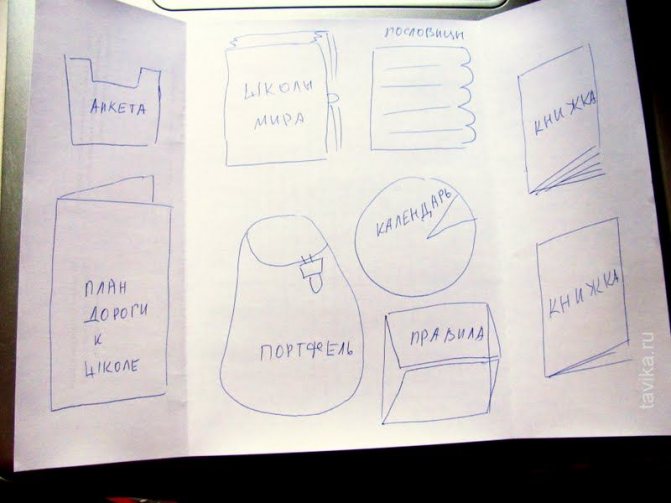
The layout can be as simple as possible and drawn on a sheet of plain white paper
- Studying the topic, searching for information. Adults should teach the child how to collect information from different sources (books, magazines, excursions, observations). You can organize a trip to a museum or library. If a child owns a computer, he can search for some information on the Internet together with his parents. Do not allow the Internet to become the only source of information - this will significantly narrow your child’s horizons and negatively affect his communication abilities.
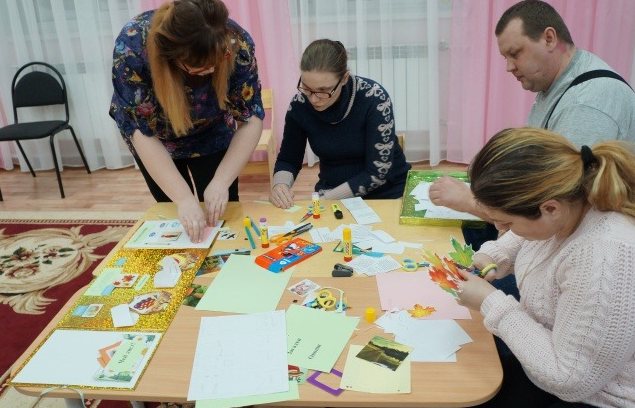
Even parents of students can be captivated by making a laptop
Lapbook technology and its application in the work of a preschool teacher.
Transcript
1 Lapbook technology and its application in the work of a preschool teacher. Modern requirements imposed by the state on the quality of educational activities in kindergarten imply that the teacher must constantly engage in self-education, improve his level of professional competence and master the necessary educational technologies. In connection with the implementation of the Federal State Educational Standard for preschool education, every teacher is looking for new approaches, ideas, forms and methods in their teaching activities that would be interesting to preschoolers and would be appropriate to their age, and would most effectively solve pedagogical, educational and educational problems. We are in a constant search for new technologies and, often, we are faced with a situation, as the saying goes, “Everything new is well forgotten old.” But the Lapbook technology is also a forgotten old thing. I decided to adopt it and apply it in my work. And I was not mistaken in my choice. As practice has shown, this decision gave my work a certain zest. Children accepted the innovation with pleasure, because “Lapbook” is a technology that allows adults to express themselves in limitless imagination, to reveal their creative abilities, and for children it makes the learning process interesting and exciting, allowing them to answer a specific question of interest in one lapbook, through different activities. This is the same fascinating book, only made with your own hands. Lapbook is a relatively new tool from America and is one of the varieties of the project method. Tatyana Aleksandrovna Pirozhenko adapted it to our mentality. She developed this technology for activities with her child and suggested using it in research work with children. Literally translated from English, lapbook means “lap book,” or, as it is also called, a thematic folder or collection of small books with pockets and windows that make it possible to place information in the form of drawings, small texts, diagrams and graphs in any form and on any topic. This is a book that the teacher collects, glues its individual parts into a single whole, and creatively designs using all kinds of colors and shapes. Most often, the basis for a lapbook is hard paper or cardboard, the main thing is that the lapbook is sized to fit on your lap. Typically, this is an A4 folder when folded and A3 when opened. Thus, I concluded that a lapbook is a collective image of a poster, book and handouts, which is aimed at developing creative potential within a given topic, expanding not only one’s horizons, but also developing skills and abilities. Lapbooks help you quickly and effectively learn new information and consolidate what you have learned in an entertaining and playful way. These thematic manuals have a bright design, a clear structure and are ideally developed
2 specifically for a specific child with his level of knowledge. The recommended age for lapbook lessons is 5 years and above. I use it to work with older and pre-school children. And children 7-8 years old can already invent and make their own lapbooks completely independently. Lapbooks can be made either by the teacher himself or together with the child. The ideal option is to make a thematic folder together with the child, then he remembers the information in the process of creating a lapbook. While working with thematic material, the child conducts observations, completes tasks, studies and consolidates information. Subsequently, having a ready-made thematic folder at hand, the child can refresh his knowledge on a particular topic. The size of the finished lapbook, as I already said, is standard around the world: A4 folder when folded and A3 when open. But I made both standard lapbook forms and more voluminous ones in A3 format. The A4 size is ideal so that a child can independently work with a lapbook: hold it in his hands, write and complete tasks in it, and after class put the folder on the shelf. After studying the literature on this topic, I identified several types of thematic folders. Depending on the purpose, they can be educational, playful, congratulatory, festive, autobiographical (a folder-report about some important event in the child’s life: travel, going to the circus, vacation leisure, etc. Depending on the form, laptops come in in the form of a standard book with two spreads, a folder with 3-5 spreads, an accordion book, a figured folder. The material on the laptop is designed as standard pockets; regular and figured envelopes; accordion pockets; book pockets; windows and doors; rotating parts; protruding details; cards; tags; arrows; puzzles; blank sheets for notes, etc. Using a lapbook in working with children is of great importance:
3 1). It helps the child organize information on the topic being studied at will and better understand and remember the material (especially if your child is visual). Adult visual learners will also enjoy this form of learning. 2). This is a great way to review what you've learned. At any convenient time, the child simply opens the laptop and happily repeats what he has learned, looking at the book he made with his own hands. 3). The child will learn to independently collect and organize information; good preparation for writing essays and term papers. 4). The laptop is well suited for classes in groups where children of different ages study at the same time. You can choose tasks that everyone can do (for kids, pockets with cards or animal figures, for example, and for older children, tasks that require the ability to write, etc.) and make such a collective book. 5). Creating a lapbook is one of the types of joint activities between adults and children, and also a form of presenting the results of a project or thematic week. To make a lapbook with your own hands, you need the following materials: cardboard base (cardboard folder, sheet of thick A3 paper, sheets of fiberboard or chipboard); paper (white, colored, scrapbooking paper with various colors and textures); printer and/or pens, pencils, markers, paints; regular and curly scissors; glue, tape, double-sided tape; stapler; decorative elements as needed (buttons, sequins, brads, pendants, paper clips, dried leaves, stickers, themed pictures cut out from magazines, etc.), in other words, everything that is in the house. Ready-made pocket templates for laptops that can be downloaded for free are the best option for beginners. However, you can try to do something of your own, original. I start working on creating a laptop by choosing a topic. The theme of the lapbook can be anything: interesting events taking place in the garden; holidays; hobbies of the teacher, children; topics of the week; literary works; cartoon characters, etc. Topics can be both general and specific. For example, you can make a general lapbook on the topic “Musical Instruments.” Or you can take a specific instrument and give detailed information about it in a lapbook. If you are making a lapbook for preschoolers, then the topics and materials for them should be elementary. In addition, if you are making a lapbook not for a group, but for one child, do not forget to focus on it: what topics need to be studied or reinforced, how advanced the child is in a particular topic. Consult with your child on what topic he would like to select material and make a folder on. These are the lapbooks I made for children: “Musical Chest”, “Russian Folk Art”.
4 After we have chosen a topic, we need to take paper and pen and write a plan. After all, a lapbook is not just a book with pictures. Therefore, you need to think about what it should include in order to fully cover the topic. And for this you need a plan of what you want to tell in this folder. Now we need to figure out how each of the points of the plan will be presented in the lapbook. That is, draw a layout. There are no limits to imagination here: presentation can take any form. From the simplest to games and educational tasks. And place all this on different elements: in pockets, notebooks, mini-books, accordion books, rotating circles, envelopes of different shapes, etc.
5 There are three main options for creating a folder: basic, basic with the addition of 1-2 extensions, and double basic. The production of such bases is shown in detail in the pictures: Next, draw several approximate layouts on a simple sheet or in Word (Paint or a design program), select the best option for placing the necessary information. Think about what your pockets (subtopics) will look like and how the information will be organized in them. Now you can start making a laptop. At this stage, the child can join in the activity. Study according to the thematic folder gradually: one lesson, one task. In conclusion, I would like to say that the Lapbook technology is very simple and effective to use, and most importantly, it is very interesting for children. I think that the Lapbook technology will successfully take root in any kindergarten. After all, it allows us to use innovative methods and forms of work towards the implementation of the Federal State Educational Standard for Education. List of used literature: 1. Lapbook, as the newest way to systematize knowledge. [Electronic resource] / Access mode: (date of access) 2. Lapbook, as part of a subject-spatial developmental environment in kindergarten. [Electronic resource] / Access mode: (date of access) 3. Consultation for teachers: “What is a lapbook?” [Electronic resource] / Access mode: appeals)
6


